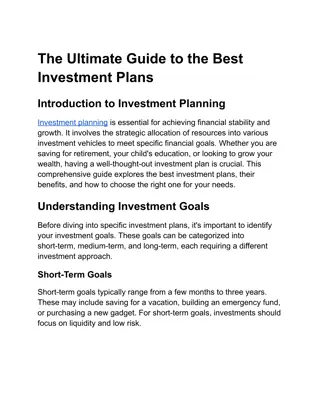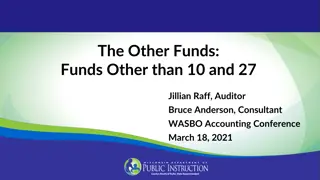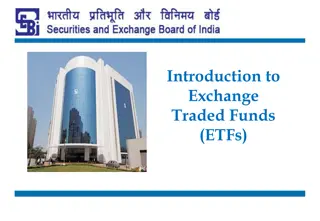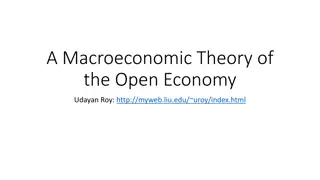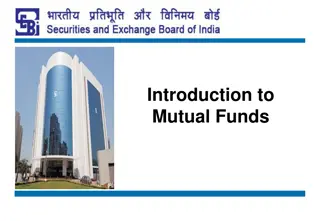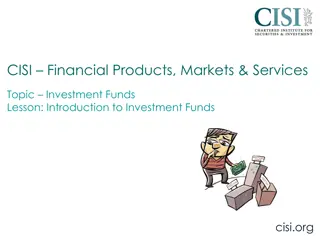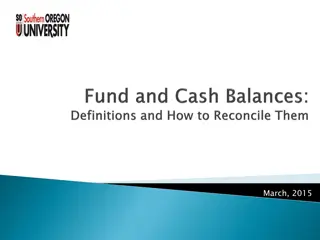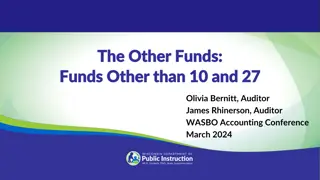Understanding Alternative Investment Funds (AIFs) and Their Categories
Explore the world of Alternative Investment Funds (AIFs), including their introduction, categories, regulations, and taxation. Discover the benefits of AIFs, such as flexibility, diversification, and potential for higher returns. Learn about the entry of AIFs in the investment domain and the various categories they encompass.
Download Presentation

Please find below an Image/Link to download the presentation.
The content on the website is provided AS IS for your information and personal use only. It may not be sold, licensed, or shared on other websites without obtaining consent from the author. Download presentation by click this link. If you encounter any issues during the download, it is possible that the publisher has removed the file from their server.
E N D
Presentation Transcript
01 INTRODUCTION 02 CATEGORIES 05 CHALLENGE 03 REGULATIONS 04 TAXATION
01 02 03 04 INTRODUCTION
ALTERNATIVE INVESTMENT FUNDS Alternative Investment Fund means any fund established or incorporated in India in the form of a trust or a company or a limited liability partnership or a body corporate which, (i) is a privately pooled investment vehicle which collects funds from investors, whether Indian or foreign, for investing it in accordance with a defined investment policy for the benefit of its investors; and (ii) is not covered under the Securities and Exchange Board of India (Mutual Funds) Regulations, 1996, Securities and Exchange Board of India (Collective Investment Schemes) Regulations, 1999 or any other regulations of the Board to regulate fund management activities. Exemptions: Family trusts ESOP trusts Employee welfare trusts Holding companies Securitization trusts
01 02 03 04 WHY AIFs
Why AIFs? Greater flexibility and scope in relation to traditional asset class Greater returns (comes with higher risk) Greater diversification, hence, low correlation Mode to make investments in quality unlisted companies and high-yielding real estate through VC and PE route Since the equity market is richly valued, HNIs are finding structured products in AIF space more attractive with capital protection along with appreciation Helps meet investors across planning spectrum, diversifying portfolio and reducing volatility
Entry Of AIFs In The Investment Domain AIFs began in the mid to late 20th century in the US, and have since grown into $7 trillion-plus industry across the world. In India, though venture capital has existed for two decades, AIFs as a distinct asset class began only after SEBI passed its 2012 regulations. Edelweiss Alpha Fund was the country's first AIF, launched in June 2013, followed by DSP BlackRock Enhanced Equity Fund in May 2014. Edelweiss's distressed assets fund, currently, is raising nearly $1 billion globally, of which $200-250 million has been carved out for domestic wealth clients.
01 02 03 04 CATEGORIES
Categories of AIFs AIFs are divided into 3 different investment structures and requirements: AIFs Category 1 AIF Category II AIF Category III AIF
Category I AIF Category I AIFs are funds with strategies to invest in start-up or early stage ventures or social ventures or SMEs or infrastructure or other sectors or areas which the government or regulators consider as socially or economically desirable. Sub-categories : Venture capital funds- In September 2013, SEBI introduced angel investment funds as a sub-class of the venture capital fund sub- category SME funds Social ventures funds Infrastructure funds AIFs which are generally perceived to have positive spillover effects on the economy and therefore, SEBI, the Government of India or other regulators may consider providing incentives or concessions shall be classified as Category I AIFs.
A Category I AIF of a particular sub-category may invest in the units of the same sub-category of Category I AIFs. However, this investment condition is subject to the further restriction that Category I AIFs are not allowed to invest in the units of Fund of Funds. Category I AIFs shall not borrow funds directly or indirectly or engage in leverage except for meeting temporary funding requirements for more than thirty days, on not more than four occasions in a year and not more than 10% of its investible funds.
Category III AIF Category III AIFs are funds which employ complex or diverse trading strategies and may employ leverage including through investment in listed or unlisted derivatives. AIFs such as hedge funds or funds which trade with a view to make short-term returns or such other funds which are open ended and for which no specific incentives or concessions are given by the Government of India or any other regulator are included in the Category III classification.
Category III AIFs may invest in the units of Category I, Category II and Category III AIFs. This is subject to the restriction that Category III AIFs cannot invest in the units of Fund of Funds; Category III AIFs engage in leverage or borrow subject to consent from investors in the fund and subject to a maximum limit as may be specified by SEBI; and
Category II AIF Category II AIFs are funds which cannot be categorized as Category I AIFs or Category III AIFs. These funds do not undertake leverage or borrowing other than to meet day-to-day operational requirements and as permitted in the AIF Regulations. AIFs such as private equity funds or debt funds for which no specific incentives or concessions are given by the Government of India or any other regulator are included in the Category II AIF classification.
Category II AIFs shall invest primarily in unlisted investee companies or in units of other AIFs as may be specified in the placement memorandum; Category II AIFs may invest in the units of Category I and Category II AIFs. This is subject to the restriction that Category II AIFs cannot invest in the units of Fund of Funds; Category II AIFs shall not borrow funds directly or indirectly or engage in leverage except for meeting temporary funding requirements for more than thirty days, on not more than four occasions in a year and not more than 10% of its investible funds; Category II AIFs may engage in hedging subject to such guidelines that may be prescribed by SEBI; Category II AIFs shall be exempt from Regulations 3 and 3A of the Insider Trading Regulations in respect of investments in companies listed on SME exchange or SME segment of an exchange pursuant to due diligence of such companies. This is subject to the further conditions that the AIF must disclose any acquisition / dealing within 2 days to the stock exchanges where the investee company is listed and such investment will be locked in for a period of 1 year from the date of investment.
Certain thresholds under AIF regulations Each AIF Scheme should have a corpus of at least Rs. 20 crores (Rs. 5 crores for Angel Fund) Each investor in AIF should commit to invest at least Rs. 1 crore (Rs. 25 lakhs for Angel Fund) An employee or director of the Manager of AIF can invest Rs. 25 lakhs or more An employee of the Manager participating in the profits/carry of the AIF need not make any investment No AIF Scheme can have more than 1,000 investors (200 investors for Angel Fund) Category I and II are close-ended funds, while category III is open-ended Cat-I AIF & Cat-II AIF shall have minimum tenue of 3 years (maximum 5 years for Angel Fund). the tenure of any AIF can be extended only with the approval of 2/3rd of the unit-holders by value of their investment in the AIF While, Category III AIFs are short termed funds, as they long-short strategies The AIF Regulations prohibit solicitation or collection of funds except by way of private placement. While the AIF Regulations do not prescribe any thresholds or rules for private placement, guidance is taken from the Companies Act, 2013. Listing-Units of close ended Alternative Investment Fund may be listed on stock exchange subject to a minimum tradable lot of one crore rupees. Such Listing of Alternative Investment Fund units shall be permitted only after final close of the fund or scheme
Registration of an AIF Eligibility Criteria for AIF Registration: MOA/Trust Deed/Partnership Deed permits carrying on the activity of AIF Trust Deed/Partnership Deed to be registered under respective governing laws MOA/Trust Deed/Partnership Deed to prohibit making an invitation to the public to subscribe its securities The Applicant, Sponsor and Manager are fit and proper based on the criteria specified in Schedule II of the Securities and Exchange Board of India (Intermediaries) Regulations, 2008 The key investment team of the investment manager of the AIF should have adequate experience with at least 1 (one) key personnel having not less than 5 years of relevant experience Manager & Sponsor has the necessary infrastructure and manpower to discharge its activities The Applicant to clearly describe investment objective, investment strategy, proposed corpus, tenure and target investors Process of registration: Self-registration on SEBI online portal and online payment of Rs. 1 lakh application fee On receipt of login and password, uploading of Form A on SEBI portal along with final PPM and copy of executed Trust Deed and requisite declarations/undertakings The entire registration process generally takes 2 to 3 months
01 02 03 04 TAXATION
Pass through status to AIFs (1/2) The Finance Act, 2015, extended tax pass through status to AIFs that are registered with SEBI as Category I AIFs or Category II AIFs under the AIF Regulations. They are governed by a special tax regime as provided under Section 115UB of the Income tax Act, 1961 (the Act) Any income (other than business income) earned by a SEBI registered Category I and II AIF, is exempt from tax in the hands of the AIF under Section 10(23FBA) of the Act. Such income shall be taxable directly in the hands of the investors of the AIF under Section 115UB of the Act. Any income distributed by investment fund is not liable for DDT u/s 115-0 Any income distributed by investment fund (except business income), TDS of 10% has to be deducted by inv fund u/s 194 LBB
Pass through status to AIFs (2/2) The investors shall be chargeable to tax in the same manner as if it were the income accruing or arising to, or received by, such investor had the investments, made by the AIF, been made directly by such investor. Income taxable in investors hands shall be deemed to be of the same nature and proportion as in the hands of the AIF. Further, in terms of Section 115UB(2) of the Act, in case there is a loss at the fund level (i.e. current loss or loss which remained to be set off), such loss shall not be allowed to be passed through to the investors but would be carried forward at AIF level to be set off against income of future years in accordance with the provisions of Chapter VI of the Act. Investment fund compulsorily required to file return u/s 139(4F)
Tax status of Category III AIFs Category III AIFs has not yet been accorded a Pass through status, which means that income from such funds will be taxed at the investment fund level and the tax obligation will not pass through to unit holders. Income under the head, Profits or gains from business or profession , the fund would be taxed in respect to such income at marginal rate of tax
05 06 07 08 PERFORMANCE
Performance of AIFs in India AIFs have witnessed humongous growth in the last few years. It has moved from nothing to raising Rs 1.17 trillion in the FY 2019, which is 70% higher than the investments made in the FY 2017-18 AIFs sensed strong opportunity: As banks took a step back, NBFCs and HFCs strived to fill the gap. But currently as they are facing liquidity crunch, AIFs have taken over by grabbing more market share in the real estate financing.
Factors important to the growth of AIFs One of the important factors of investing in AIFs is the investment approach. The goal of AIFs is to optimise returns and not necessarily to maximise them AIFs invest in start-ups, real estate, private equity and more, some of them using strategies which mutual funds are not allowed to - such as taking a combination of 'long' and 'short' positions on stocks. Increasing awareness and educated sound investors are the crucial factors leading to its growth.
The true test of AIFs will be to show positive returns when markets are down. There is every likelihood of such a test in the near future. Avendus Enhanced Return Fund (AERF), launched by global financial services company Avendus in India in December 2017, provided overall returns of 11.71 per cent till end-June this year. Ambit Alpha Fund (AAF), run by domestic financial services heavyweight Edelweiss Asset Management - which it acquired from Ambit Investment Advisors in September 2016 - has delivered 12-15 per cent returns every month, without once going negative, even after witnessing constant fall in Nifty in the given duration
05 06 07 08 CHALLENGE
Challenge faced by AIFs in India One of the major challenge faced by AIFs in india is the paucity of talent. While investing in an AIF, the track record and credibility of the people managing it is crucial. But it is expected that soon, there will be niche and boutique competition from skilled fund managers who prefer to start independent practices rather than join institutional offerings.




